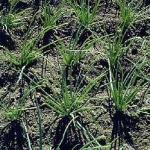| Common Name: |
Shallot |
| Other Names: |
Green Onion, Onion |
| Botanical Name: |
Allium cepa |
| Genus: |
Allium |
| Family: |
Alliaceae |
| Cultivation: |
Rich, well-drained soil in full sun. Allium schoenoprasum tolerates wetter conditions, heavier soil, and a less open position than most other alliums. Allium atricoccum and A. ursinum prefer moist soil in shade. Allium fistulosum may be hilled up, like leeks, to produce blanched stems. Cut A. schoenoprasum down to the ground after flowering to produce fresh leaves. Onion maggot is common in some countries on light soils; downy mildew is prevalent in wet weather; rots may effect both growing and stored bulbs. Onions, garlic, and chives are often recommended in companion planting to deter pests, weeds, and diseases, though both are reputed to affect legumes adversely. |
| Propagation: |
By seed sown in spring; by bulbils planted in autumn or spring (A. ampeloprasum). By seed sown in autumn or spring, or by "sets" (small bulbs), planted in spring (A.cepa). Sowing and planting of cultivars of A. cepa vary widely in different climates. By seed sown in succession in spring for summer use, and in summer for autumn and spring use (A. fistulosum). By bulbs or individual cloves planted in autumn or winter (A. sativum). By seed sown in spring; by bulbs planted when dormant (A. tricoccum, A ursinum). |
| Harvest: |
Allium ampeloprasum, A. cepa, and A. sativum are harvested in late summer and early autumn. Allium cepa and A. sativum are left to dry in the sun before being stored at 3-5°C (37-41°F). Allium fistulosum is pulled when the stems are pencil thick, or left until leek-sized, and used fresh or quickly cooked. Allium schoenoprasum is cut as needed in the growing season. It is best used fresh or finely chopped and frozen. Allium triccocum, A. tuberosum, and A. ursinum are gathered to be used fresh. Allium tuberosum is blanched in China using clay pots or straw "tents" to give tender leaves that are eaten raw in finger-length pieces. |
| Native Location: |
Worldwide |
| Height: |
1.2m (4ft) |
| Width: |
15cm (6in) |
| Variations: |
Aggregatum Group
(Potato onion, multiplier onion, shallot)
produces a cluster of smaller bulbs, rather than one large bulb.
Aggregatum Group 'Perutile'
(Ever-ready onion, everlasting onion)
forms dense clubs of leaves 30cm (12in) high, similar to but milder and more tender than Welsh Onion
'Ailsa Craig'
produces a round bulb with straw-colored skin and mild flavor. Grown from seed sown in winter, it has long been popular as a large exhibition onion.
Height: 30-45cm (12-18in)
Width: 30cm (12in).
'Noorhollandse Bloedrode'
(North Holland Blood Red)
Is mild flavored with deep red bulbs and pink flesh. It is easily grown from seed and stores well.
Height: 30-45cm (12-18in)
Width: 15-30cm (6-12in)
Proliferum Group
(Tree onion, Catawissa onion, Egyptian onion)
Produces large bulbils among the flowers, sprouting leaves while still attached to the umbel.
Height: 1m (3ft)
Width: 30cm (1ft)
Sweet Sandwhich
Has large, globose, brown-skinned bulbs which become exceptionally mild and sweet after about 2 months in storage.
Height: 30-45cm (12-18in)
Width: 15-30cm (6-12in) |
| Hardiness: |
Z4-9 |
| Parts Used: |
Bulb, fresh juice |
| Properties: |
A pungent herb that protects against infection, relaxes spasms, and reduces blood pressure, clotting, and blood sugar levels. It is expectorant and diuretic. |
| Medicinal Uses: |
Internally for bronchial and gastric infections, (liquid extract of bulbs). Externally for acne and boils.
To treat digestive problems, cough, colds, whooping cough, asthma, angina, worm infestation, and bacterial or fungal infections; to improve the gall-bladder's performance. Germany's Commission E has approved the use of onion to treat arteriosclerosis, cough, bronchitis, fevers, colds, hypertension, dyspeptic complaints such as heartburn and loss of appetite, tendency to infection, and inflammation of the mouth and throat. |
| Typical Dose: |
A typical daily dose is approximately 50 gm of fresh onion or fresh onion juice, or 20 gm of dried onion. |
| Possible Side Effects: |
Onion's side effects include gastrointestinal distress and halitosis. |
| Drug Interactions: |
| Taking onion with these drugs may increase the risk of bleeding or bruising: |
| Abciximab, (ReoPro) |
Aspirin, (Bufferin, Ecotrin) |
Celecoxib, (Celebrex) |
| Enoxaparin, (Lovenox) |
Etodolac, (Lodine, Utradol) |
Heparin, (Hepalean, Hep-Lock) |
| Ibuprofen, (Advil, Motrin) |
Indomethacin, (Indocin, Novo-Methacin) |
Ketoprofen, (Orudis, Rhodis) |
| Ketorolac, (Acular, Toradol) |
Ticlopidine, (Alti-Ticlopidine, Ticlid) |
Urokinase, (Abbokinase) |
| Warfarin, (Coumadin, Jantoven) |
| Taking onion with these drugs may increase the risk of hypoglycemia (low blood sugar): |
| Acarbose, (Prandase, Precose) |
Acetohexamide, (Acetohexamide) |
Chlorpropamide, (Diabinese, Novo-Propamide) |
Gliclazide, (Diamicron, Novo-Gliclazide) |
| Glimepiride, (Amaryl) |
Glipizide, (Glucotrol) |
Glipizide and Metformin, (Metaglip) |
Gliquidone, (Beglynor, Glurenorm) |
| Glyburide, (DiaBeta, Micronase) |
Glyburide and Metformin, (Glucovance) |
Insulin, (Humulin, Novolin R) |
Metformin, (Glucophage, Riomet) |
| Miglitol, (Glyset) |
Nateglinide, (Starlix) |
Pioglitazone, (Actos) |
Repaglinide, (GlucoNorm, Prandin) |
| Rosiglitazone, (Avandia) |
Rosiglitazone and Metformin, (Avandamet) |
Tolazamide, (Tolinase) |
Tolbutamide, (Apo-Tolbutamide, Tol-Tab) |
|
| Lab Test Alterations: |
May decrease blood glucose levels. |
| Supplement Interactions: |
Increased risk of bleeding when used with herbs and supplements that might affect platelet aggregation. |
| Culinary Uses: |
Cooked or raw, onions are indispensable as a flavoring for most meat and vegetable dishes, sauces, stocks, and chutneys. They are also eaten raw or cooked as a vegetable and as pickles with bread and cheese. Dehydrated onion is an ingredient of salt substitutes. Fermented onion paste, hrous, is used as a flavoring for couscous, stews and soups (Tunisia). |
| Bibliography: |
Encyclopedia of Herbs by Deni Brown. Copyright © 1995, 2001 Dorling Kindersley Limited. pp 111, 113
The Essential Herb-Drug-Vitamin Interaction Guide by Geo. T. Grossberg,MD and Barry Fox,PhD Copyright©2007 Barry Fox,PhD. Pp.357-358
|

